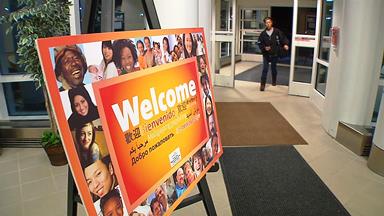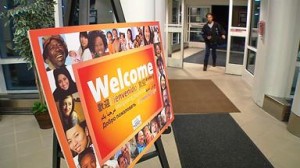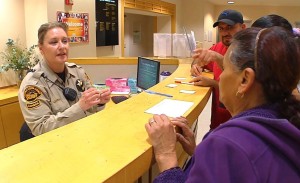
The clock hands turn to 8 pm and an overhead announcement is heard throughout the hospital’s halls, “Visiting hours will be ending in 30 minutes.” At Contra Costa Regional Medical Center (CCRMC) and at many other hospitals throughout the nation, this has been a heart-wrenching moment between patients and their loved ones.
 We at CCRMC realized that we could do better than this for our patients, so we took a step back to learn. We learned that this systematic separation was hardly conducive to a healing environment. We recognize the great benefits a patient receives while having loved-ones by his/her side during care transitions and moments of decision-making. In 2013 CCRMC made it a priority to respect family members/care partners as a valuable part of the patient’s care team by transforming our long-standing “Visitor Policy” in to what is now known as our “Welcoming Policy.”
We at CCRMC realized that we could do better than this for our patients, so we took a step back to learn. We learned that this systematic separation was hardly conducive to a healing environment. We recognize the great benefits a patient receives while having loved-ones by his/her side during care transitions and moments of decision-making. In 2013 CCRMC made it a priority to respect family members/care partners as a valuable part of the patient’s care team by transforming our long-standing “Visitor Policy” in to what is now known as our “Welcoming Policy.”
Striving for a Healing Environment
Hospital administration began by organizing a multi-disciplinary team including staff, patients, family members and loved ones to better understand the feasibility of changing our system to support this new policy. Interestingly, our background findings showed that we were the “laggards” in this movement; we had to catch up to the innovation set by our front line staff who had recognized the problem early on. We found that hospital staff had been “sneaking in” patient’s loved ones during non-visitation hours for years. These staff members understood what a true healing environment was and how much could be gained by having a loved one nearby to help answer questions and explain preferences.
Putting the Welcome Mat Out
Realizing that WE are the visitors in our patient’s lives, we decided that simply being open 24/7 is not enough, and that we needed to make some systemic changes. The Welcoming Policy now allows patients to define family for themselves and ensures that their loved ones are integral to the process of patient care. Today, there’s a key difference in the manner loved ones are welcomed and invited, and there’s a difference in the way we help them participate in care. This has been a huge cultural shift, one that the staff here was courageous and caring enough to undertake.
We searched for models to emulate, and then we adapted those methods to fit our system. We found a few examples, and we knew we would be among the pioneers in adapting these new approaches. Research conducted in 2013 found that 76.4 percent of U.S. hospitals had hospital-wide visitation policies, and 89.6 percent had intensive care unit restrictions (Liu, V., et al., “Visitation Policies and Practices in U.S. ICUs,” Critical Care, 2013, vol. 17, no. 2, p. R71).
Assuring Privacy and Security
 As the policy supporting infrastructure and standard work began to take form, we knew ensuring safety was a concern for staff. Some staff members had concerns about managing a patient’s nighttime privacy with an unprecedented number of nighttime visitors, and whether the unlocked lobby doors would bring security risks. To address this, we engaged Sheriff Rangers to greet guests, issue name tags, and alert hospital staff of visitors. We all knew this was going to be a challenge and after several months of preparation, we rolled out the new policy. On September 17, 2013, executive leaders stood next to frontline staff, welcoming loved ones during late evening and overnight hours.
As the policy supporting infrastructure and standard work began to take form, we knew ensuring safety was a concern for staff. Some staff members had concerns about managing a patient’s nighttime privacy with an unprecedented number of nighttime visitors, and whether the unlocked lobby doors would bring security risks. To address this, we engaged Sheriff Rangers to greet guests, issue name tags, and alert hospital staff of visitors. We all knew this was going to be a challenge and after several months of preparation, we rolled out the new policy. On September 17, 2013, executive leaders stood next to frontline staff, welcoming loved ones during late evening and overnight hours.
Since 2013, more than 10,000 loved ones have had the opportunity to provide support to our patients long after traditional visiting hours would have been over. This could not have happened without the assistance of our dedicated staff, and patient and family member partners. The team’s successful partnership with patients and families on welcoming policy has paved the way for our organization to actively engage our patients at all levels of operation. Today, our patients are one of the most vital partners we have in our organization.
For more information, visit our website: http://cchealth.org/medicalcenter/welcome-policy.php
Editor’s note: John Q. Sherman Award judges were impressed by the collective efforts of Contra Costa and its patients and families to create a welcoming, healing environment. You can read further details in their award nomination here.




